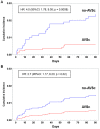Aortic Valve Sclerosis Adds to Prediction of Short-Term Mortality in Patients with Documented Coronary Atherosclerosis
- PMID: 31387275
- PMCID: PMC6722808
- DOI: 10.3390/jcm8081172
Aortic Valve Sclerosis Adds to Prediction of Short-Term Mortality in Patients with Documented Coronary Atherosclerosis
Abstract
Aims: Aortic valve sclerosis (AVSc), a non-uniform thickening of leaflets with an unrestricted opening, is characterized by inflammation, lipoprotein deposition, and matrix degradation. In the general population, AVSc predicts long-term cardiovascular mortality (+50%) even after adjustment for vascular risk factors and clinical atherosclerosis. We have hypothesized that AVSc is a risk-multiplier able to predict even short-term mortality. To address this issue, we retrospectively analyzed 90-day mortality of all patients who underwent isolated coronary artery bypass grafting (CABG) at Centro Cardiologico Monzino over a ten-year period (2006-2016).
Methods: We analyzed 2246 patients and 90-day all-cause mortality was 1.5% (31 deaths). We selected only patients deceased from cardiac causes (n = 29) and compared to alive patients (n = 2215). A cardiologist classified the aortic valve as no-AVSc (n = 1352) or AVSc (n = 892). Cox linear regression and integrated discrimination improvement (IDI) analyses were used to evaluate AVSc in predicting 90-day mortality.
Results: AVSc 90-day survival (97.6%) was lower than in no-AVSc (99.4%; p < 0.0001) with a hazard ratio (HR) of 4.0 (95%CI: 1.78, 9.05; p < 0.0001). The HR for AVSc, adjusted for propensity score, was 2.7 (95%CI: 1.17, 6.23; p = 0.02) and IDI statistics confirmed that AVSc significantly adds (p < 0.001) to the identification of high-risk patients than EuroSCORE II alone.
Conclusion: Our data supports the hypothesis that a risk stratification strategy based on AVSc, added to ESII, may allow better recognition of patients at high-risk of short-term mortality after isolated surgical myocardial revascularization. Results from this study warrant further confirmation.
Keywords: EuroSCORE II; aortic valve sclerosis; surgical myocardial revascularization; survival.
Conflict of interest statement
The authors declare no conflict of interest.
Figures


Similar articles
-
Aortic Valve Sclerosis as an Important Predictor of Long-Term Mortality in Patients With Carotid Atheromatous Plaque Requiring Carotid Endarterectomy.Front Cardiovasc Med. 2021 May 28;8:653991. doi: 10.3389/fcvm.2021.653991. eCollection 2021. Front Cardiovasc Med. 2021. PMID: 34124193 Free PMC article.
-
Aortic Valve Sclerosis in High-Risk Coronary Artery Disease Patients.Front Cardiovasc Med. 2021 Jul 27;8:711899. doi: 10.3389/fcvm.2021.711899. eCollection 2021. Front Cardiovasc Med. 2021. PMID: 34386534 Free PMC article.
-
Non-stenotic fibro-calcific aortic valve as a predictor of myocardial infarction recurrence.Eur J Prev Cardiol. 2024 Feb 14:zwae062. doi: 10.1093/eurjpc/zwae062. Online ahead of print. Eur J Prev Cardiol. 2024. PMID: 38365224
-
Markers of subclinical atherosclerosis in patients with aortic valve sclerosis: A meta-analysis of literature studies.Int J Cardiol. 2016 Nov 15;223:364-370. doi: 10.1016/j.ijcard.2016.08.122. Epub 2016 Aug 9. Int J Cardiol. 2016. PMID: 27543711 Review.
-
Stroke Rates Following Surgical Versus Percutaneous Coronary Revascularization.J Am Coll Cardiol. 2018 Jul 24;72(4):386-398. doi: 10.1016/j.jacc.2018.04.071. J Am Coll Cardiol. 2018. PMID: 30025574
Cited by
-
Aortic Valve Sclerosis as an Important Predictor of Long-Term Mortality in Patients With Carotid Atheromatous Plaque Requiring Carotid Endarterectomy.Front Cardiovasc Med. 2021 May 28;8:653991. doi: 10.3389/fcvm.2021.653991. eCollection 2021. Front Cardiovasc Med. 2021. PMID: 34124193 Free PMC article.
-
Cardiac Autonomic Response to Active Standing in Calcific Aortic Valve Stenosis.J Clin Med. 2021 May 7;10(9):2004. doi: 10.3390/jcm10092004. J Clin Med. 2021. PMID: 34067025 Free PMC article.
-
Whole-Blood Transcriptome Unveils Altered Immune Response in Acute Myocardial Infarction Patients With Aortic Valve Sclerosis.Arterioscler Thromb Vasc Biol. 2024 Feb;44(2):452-464. doi: 10.1161/ATVBAHA.123.320106. Epub 2023 Dec 21. Arterioscler Thromb Vasc Biol. 2024. PMID: 38126173 Free PMC article.
-
Aortic Valve Sclerosis in High-Risk Coronary Artery Disease Patients.Front Cardiovasc Med. 2021 Jul 27;8:711899. doi: 10.3389/fcvm.2021.711899. eCollection 2021. Front Cardiovasc Med. 2021. PMID: 34386534 Free PMC article.
-
Prognostic significance of early stage aortic valve disease development in heart failure: insights from the MECKI score cohort.Eur Heart J Open. 2025 Jun 6;5(3):oeaf066. doi: 10.1093/ehjopen/oeaf066. eCollection 2025 May. Eur Heart J Open. 2025. PMID: 40574804 Free PMC article.
References
-
- Nishimura R.A., Otto C.M., Bonow R.O., Carabello B.A., Erwin J.P., 3rd, Fleisher L.A., Jneid H., Mack M.J., McLeod C.J., O’Gara P.T., et al. 2017 AHA/ACC focused update of the 2014 AHA/ACC guideline for the management of patients with valvular heart disease: A Report of the American College of Cardiology/American Heart Association task force on clinical practice guidelines. Circulation. 2017 doi: 10.1161/CIR.0000000000000503. - DOI - PubMed
-
- Poggio P., Branchetti E., Grau J.B., Lai E.K., Gorman R.C., Gorman J.H., 3rd, Sacks M.S., Bavaria J.E., Ferrari G. Osteopontin-CD44v6 interaction mediates calcium deposition via phospho-Akt in valve interstitial cells from patients with noncalcified aortic valve sclerosis. Arterioscler Thromb. Vasc. Biol. 2014;34:2086–2094. doi: 10.1161/ATVBAHA.113.303017. - DOI - PMC - PubMed
-
- Chandra H.R., Goldstein J.A., Choudhary N., O’Neill C.S., George P.B., Gangasani S.R., Cronin L., Marcovitz P.A., Hauser A.M., O’Neill W.W. Adverse outcome in aortic sclerosis is associated with coronary artery disease and inflammation. J. Am. Coll. Cardiol. 2004;43:169–175. doi: 10.1016/j.jacc.2003.08.036. - DOI - PubMed

